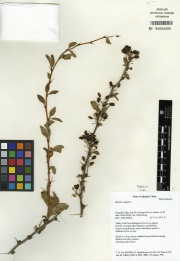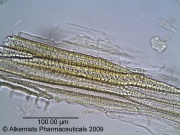From AHPA Botanical Identity References Compendium
(Difference between revisions)
|
|
| Line 52: |
Line 52: |
| | =High Performance Thin Layer Chromatographic Identification= | | =High Performance Thin Layer Chromatographic Identification= |
| | =Supplementary Information= | | =Supplementary Information= |
| − | [[Category:NoIntro]]
| + | =Sources= |
| | + | <references /> |
Revision as of 22:22, 15 March 2014
Nomenclature
Berberis vulgaris L. Berberidaceae
Standardized common name (English): barberry
Botanical Voucher Specimen
Organoleptic Characteristics
Macroscopic Characteristics
| Nepaul Barberry—Berberis vulgaris L. (Barberry).
B. vulgaris is a spreading shrub, from four to six feet or more in height, with thorny branches, a light gray bark and a fine yellow wood.
The berries of B. vulgaris, which grow in loose bunches, are oblong and of a red color, have a grateful, sour, astringent taste, and contain malic and citric acids.
The bark of the root is grayish on the outside, yellow within, very bitter, and stains the saliva when chewed. Brandes found in 100 parts of the root 6.63 of bitter, yellow extractive (impure berberine), 1.55 of brown coloring matter, 0.35 of gum, 0.20 of starch, 0.10 of cerin, 0.07 of stearin, 0.03 of chlorophyll, 0.55 of a sub-resin, 55.40 of lignin, and 35.00 of water.
Source: United States Dispensatory (1918) [2]
|
|
|
|
Microscopic Characteristics
| Sclerenchymatous bast fibers showing tapered ends observed at 400x with Acidified Chloral Hydrate Glycerol Solution.
Source: Elan M. Sudberg, Alkemist Laboratories [3]
|
|
|
|
High Performance Thin Layer Chromatographic Identification
Supplementary Information
Sources
- ↑ MOBOT, Tropicos.org http://www.tropicos.org/Image/100187927
- ↑ United States Dispensatory (1918)
- ↑ Elan M. Sudberg, Alkemist Laboratories http://www.Alkemist.com


